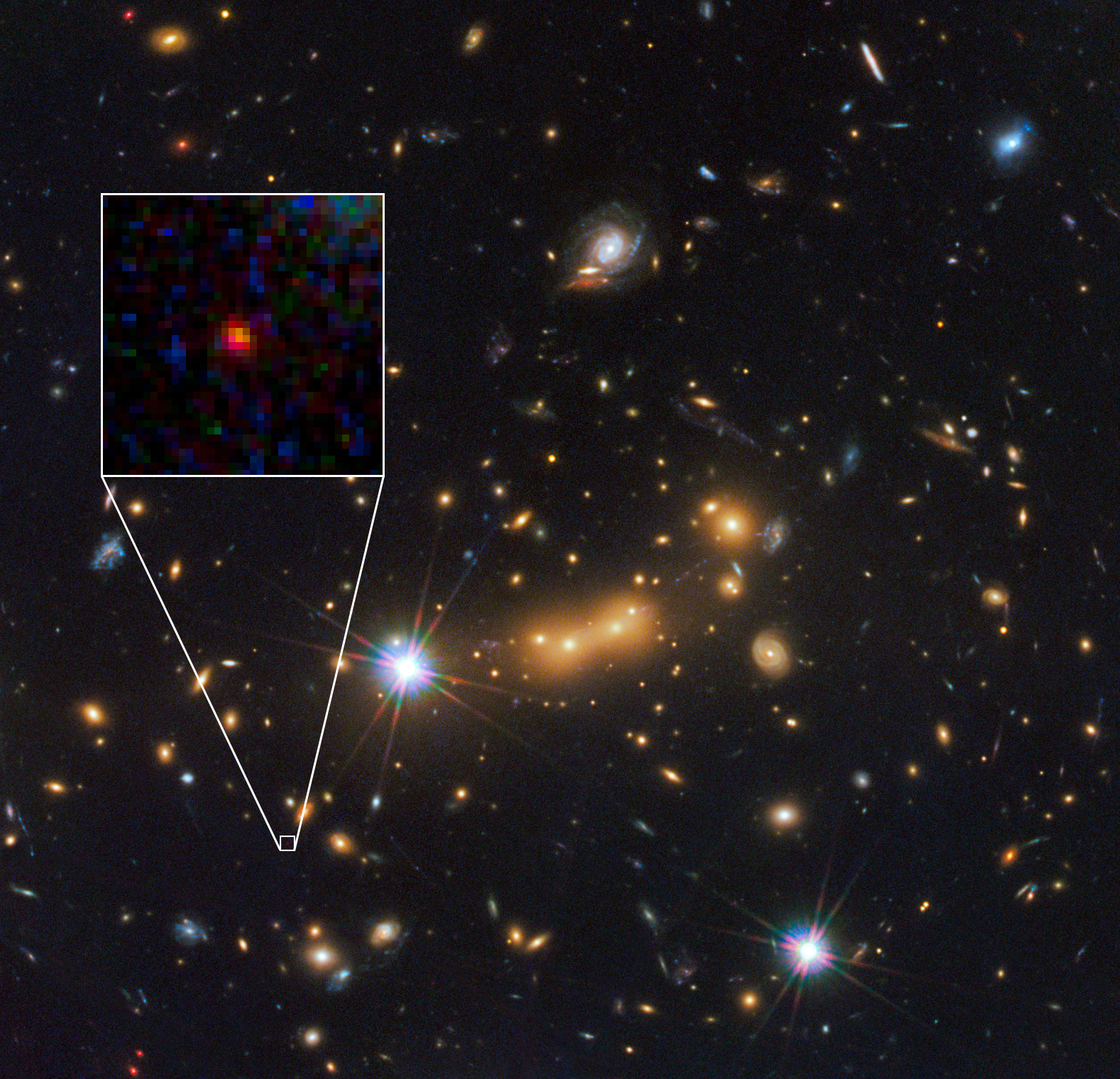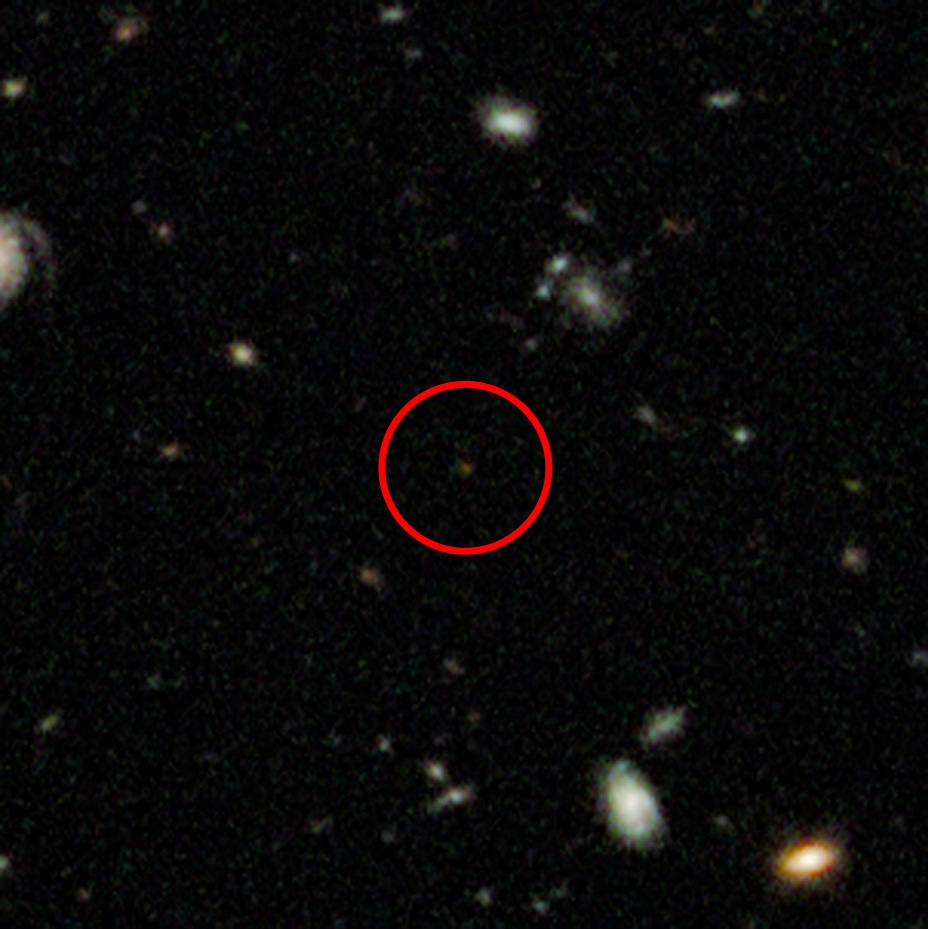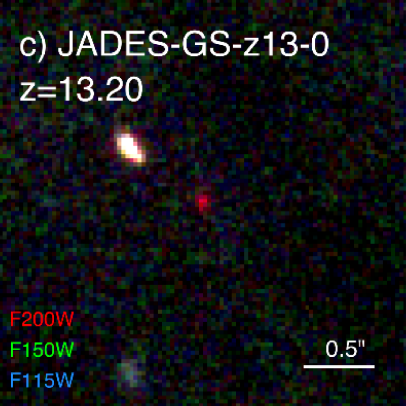|
UDFj-39546284
__NOTOC__ UDFj-39546284 is a high- redshift Lyman-break galaxy discovered by the Hubble Space Telescope in infrared Hubble Ultra-Deep Field (HUDF) observations in 2009. The object, located in the Fornax constellation, was identified by G. Illingworth (UC Santa Cruz), R. Bouwens (UC Santa Cruz and Leiden University) and the HUDF09 Team during 2009 and 2010. It was reported with a redshift of ''z''~10 using Hubble and Spitzer Space Telescope photometric data, with later reports in 2012 suggesting a possibly higher redshift of ''z'' = 11.9 Although doubts were raised that this galaxy could instead be a low-redshift interloper with extreme spectral emission lines producing the appearance of a very high redshift source, later spectroscopic observations by the James Webb Space Telescope's NIRSpec instrument in 2022 confirmed the galaxy's high redshift to a spectroscopically confirmed estimate of ''z'' = 10.38. Gallery File:Hudf09z10nl.png, UDFj-39546284 File:UDFj-39546284.tif, ... [...More Info...] [...Related Items...] OR: [Wikipedia] [Google] [Baidu] |
MACS0647-JD
__NOTOC__ MACS0647-JD is a galaxy with a redshift of about ''z'' = 10.7, equivalent to a light travel distance of 13.26 billion light-years (4 billion parsecs). If the distance estimate is correct, it formed about 427 million years after the Big Bang. Details JD refers to ''J-band Dropout'' – the galaxy was not detected in the so-called J-band (F125W), nor in 14 bluer Hubble filters. It only appeared in the two reddest filters (F140W and F160W). It is less than 600 light-years wide, and contains roughly a billion stars. The galaxy was discovered with the help of Cluster Lensing And Supernova survey with Hubble (CLASH), which uses massive galaxy clusters as cosmic telescopes to magnify distant galaxies behind them, an effect called gravitational lensing. Observations were recorded by the Wide Field Camera 3 on the Hubble Space Telescope, with support from Spitzer Space Telescope. The location of the galaxy is in the constellation Camelopardalis, which is also the location of ... [...More Info...] [...Related Items...] OR: [Wikipedia] [Google] [Baidu] |
Fornax (constellation)
Fornax () is a constellation in the southern celestial hemisphere, partly ringed by the celestial river Eridanus. Its name is Latin for furnace. It was named by French astronomer Nicolas Louis de Lacaille in 1756. Fornax is one of the 88 modern constellations. The three brightest stars—Alpha, Beta and Nu Fornacis—form a flattened triangle facing south. With an apparent magnitude of 3.91, Alpha Fornacis is the brightest star in Fornax. Six star systems have been found to have exoplanets. The Fornax Dwarf galaxy is a small faint satellite galaxy of the Milky Way. NGC 1316 is a relatively close radio galaxy. It is the 41st largest constellation in the night-sky, occupying an area of 398 square degrees. It is located in the first quadrant of the southern hemisphere (SQ1) and can be seen at latitudes between +50° and -90° during the month of December. History The French astronomer Nicolas Louis de Lacaille first described the constellation in French as ''le Fourneau Chy ... [...More Info...] [...Related Items...] OR: [Wikipedia] [Google] [Baidu] |
Fornax
Fornax () is a constellation in the southern celestial hemisphere, partly ringed by the celestial river Eridanus. Its name is Latin for furnace. It was named by French astronomer Nicolas Louis de Lacaille in 1756. Fornax is one of the 88 modern constellations. The three brightest stars—Alpha, Beta and Nu Fornacis—form a flattened triangle facing south. With an apparent magnitude of 3.91, Alpha Fornacis is the brightest star in Fornax. Six star systems have been found to have exoplanets. The Fornax Dwarf galaxy is a small faint satellite galaxy of the Milky Way. NGC 1316 is a relatively close radio galaxy. It is the 41st largest constellation in the night-sky, occupying an area of 398 square degrees. It is located in the first quadrant of the southern hemisphere (SQ1) and can be seen at latitudes between +50° and -90° during the month of December. History The French astronomer Nicolas Louis de Lacaille first described the constellation in French as ''le Fourneau Chy ... [...More Info...] [...Related Items...] OR: [Wikipedia] [Google] [Baidu] |
UDFy-38135539
UDFy-38135539 (also known as "HUDF.YD3") is the Hubble Ultra Deep Field (UDF) identifier for a galaxy which was calculated to have a light travel time of 13.1 billion years with a present proper distance of around 30 billion light-years. It was discovered by three teams in September 2009 in sensitive infrared Hubble Space Telescope images and identified by these as source UDF-38135539 ( R Bouwens ''et al.''), source HUDF.YD3 (A Bunker ''et al.'') and source 1721 (R McLure ''et al.''), and additionally reported in the ''Astrophysical Journal'', and the ''Monthly Notices of the Royal Astronomical Society''. All teams independently identified the source to likely be an extremely distant galaxy because there was no measurable light at visible wavelengths (caused by absorption of hydrogen gas along the line of sight). Following the discovery of this candidate distant galaxy, another team targeted this object with ground-based spectroscopy to confirm the distance, reporting a reds ... [...More Info...] [...Related Items...] OR: [Wikipedia] [Google] [Baidu] |
List Of The Most Distant Astronomical Objects
This article documents the most distant astronomical objects discovered and verified so far, and the time periods in which they were so classified. For comparisons with the light travel distance of the astronomical objects listed below, the age of the universe since the Big Bang is currently estimated as 13.787±0.020 Gyr. Distances to remote objects, other than those in nearby galaxies, are nearly always inferred by measuring the cosmological redshift of their light. By their nature, very distant objects tend to be very faint, and these distance determinations are difficult and subject to errors. An important distinction is whether the distance is determined via spectroscopy or using a photometric redshift technique. The former is generally both more precise and also more reliable, in the sense that photometric redshifts are more prone to being wrong due to confusion with lower redshift sources that may have unusual spectra. For that reason, a spectroscopic redshift is conventio ... [...More Info...] [...Related Items...] OR: [Wikipedia] [Google] [Baidu] |
List Of Galaxies
The following is a list of notable galaxies. There are about 51 galaxies in the Local Group (see list of nearest galaxies for a complete list), on the order of 100,000 in the Local Supercluster, and an estimated 100 billion in all of the observable universe. The discovery of the nature of galaxies as distinct from other nebulae (interstellar clouds) was made in the 1920s. The first attempts at systematic catalogues of galaxies were made in the 1960s, with the Catalogue of Galaxies and Clusters of Galaxies listing 29,418 galaxies and galaxy clusters, and with the Morphological Catalogue of Galaxies, a putatively complete list of galaxies with photographic magnitude above 15, listing 30,642. In the 1980s, the Lyons Groups of Galaxies listed 485 galaxy groups with 3,933 member galaxies. Galaxy Zoo is a project aiming at a more comprehensive list: launched in July 2007, it has classified over one million galaxy images from The Sloan Digital Sky Survey, The Hubble Space Telescope ... [...More Info...] [...Related Items...] OR: [Wikipedia] [Google] [Baidu] |
BDF-3299
BDF-3299 is a remote galaxy with a redshift of z = 7.109 corresponds to a distance traveled by light to come down to Earth of 12.9 billion light-years. See also * List of most distant galaxies *List of the most distant astronomical objects This article documents the most distant astronomical objects discovered and verified so far, and the time periods in which they were so classified. For comparisons with the light travel distance of the astronomical objects listed below, the age of ... Sources * Galaxies Piscis Austrinus {{galaxy-stub ... [...More Info...] [...Related Items...] OR: [Wikipedia] [Google] [Baidu] |
Hubble Ultra-Deep Field
The Hubble Ultra-Deep Field (HUDF) is a deep-field image of a small region of space in the constellation Fornax, containing an estimated 10,000 galaxies. The original data for the image was collected by the Hubble Space Telescope from September 2003 to January 2004. It includes light from galaxies that existed about 13 billion years ago, some 400 to 800 million years after the Big Bang. The HUDF image was taken in a section of the sky with a low density of bright stars in the near-field, allowing much better viewing of dimmer, more distant objects. Located southwest of Orion in the southern-hemisphere constellation Fornax, the rectangular image is 2.4 arcminutes to an edge, or 3.4 arcminutes diagonally. This is about one-tenth of the angular diameter of a full moon viewed from Earth (less than 34 arcminutes), smaller than a 1 mm2 piece of paper held 1 m away, and equal to roughly one twenty-six-millionth of the total area of the sky. The image is oriented so that th ... [...More Info...] [...Related Items...] OR: [Wikipedia] [Google] [Baidu] |
Rychard Bouwens
Rychard J. Bouwens is an associate professor at Leiden University. He is also a former member of the Advanced Camera for Surveys Guaranteed Time Observation team and postdoctoral research astronomer at the University of California, Santa Cruz. He obtained his bachelor's degree in physics, chemistry, and mathematics from Hope College. He then went on to earn his Ph.D. in physics at the University of California, Berkeley under the supervision of Joseph Silk and also worked with Tom Broadhurst. He works on the interpretation of high redshift starbursts. He helped create the Bouwens' Universe Construction Set (BUCS), which can simulate arbitrary galaxy fields and calculate any galaxy observables. Throughout his career, he has broken the record for discovering the most distant galaxy in the universe, including three sources in 2015–2016 with record-breaking spectroscopic redshift measurements at z=7.73 (see EGS-zs8-1), z=8.68 (see EGSY8p7), and z=11.1 (see GN-z11). In a 2011 ... [...More Info...] [...Related Items...] OR: [Wikipedia] [Google] [Baidu] |
Hubble Space Telescope
The Hubble Space Telescope (often referred to as HST or Hubble) is a space telescope that was launched into low Earth orbit in 1990 and remains in operation. It was not the first space telescope, but it is one of the largest and most versatile, renowned both as a vital research tool and as a public relations boon for astronomy. The Hubble telescope is named after astronomer Edwin Hubble and is one of NASA's Great Observatories. The Space Telescope Science Institute (STScI) selects Hubble's targets and processes the resulting data, while the Goddard Space Flight Center (GSFC) controls the spacecraft. Hubble features a mirror, and its five main instruments observe in the ultraviolet, visible, and near-infrared regions of the electromagnetic spectrum. Hubble's orbit outside the distortion of Earth's atmosphere allows it to capture extremely high-resolution images with substantially lower background light than ground-based telescopes. It has recorded some of the most detaile ... [...More Info...] [...Related Items...] OR: [Wikipedia] [Google] [Baidu] |
James Webb Space Telescope
The James Webb Space Telescope (JWST) is a space telescope which conducts infrared astronomy. As the largest optical telescope in space, its high resolution and sensitivity allow it to view objects too old, distant, or faint for the Hubble Space Telescope. This will enable investigations across many fields of astronomy and cosmology, such as observation of the first stars, the formation of the first galaxies, and detailed atmospheric characterization of potentially habitable exoplanets. The U.S. National Aeronautics and Space Administration (NASA) led JWST's design and development and partnered with two main agencies: the European Space Agency (ESA) and the Canadian Space Agency (CSA). The NASA Goddard Space Flight Center (GSFC) in Maryland managed telescope development, the Space Telescope Science Institute in Baltimore on the Homewood Campus of Johns Hopkins University operates JWST, and the prime contractor was Northrop Grumman. The telescope is named after James E. Webb, ... [...More Info...] [...Related Items...] OR: [Wikipedia] [Google] [Baidu] |
Astronomical Objects Discovered In 2011
Astronomy () is a natural science that studies celestial objects and phenomena. It uses mathematics, physics, and chemistry in order to explain their origin and evolution. Objects of interest include planets, moons, stars, nebulae, galaxies, and comets. Relevant phenomena include supernova explosions, gamma ray bursts, quasars, blazars, pulsars, and cosmic microwave background radiation. More generally, astronomy studies everything that originates beyond Earth's atmosphere. Cosmology is a branch of astronomy that studies the universe as a whole. Astronomy is one of the oldest natural sciences. The early civilizations in recorded history made methodical observations of the night sky. These include the Babylonians, Greeks, Indians, Egyptians, Chinese, Maya, and many ancient indigenous peoples of the Americas. In the past, astronomy included disciplines as diverse as astrometry, celestial navigation, observational astronomy, and the making of calendars. Nowadays, professional a ... [...More Info...] [...Related Items...] OR: [Wikipedia] [Google] [Baidu] |







